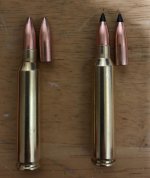I am fairly new to reloading, and have been able to learn a lot from forums and YouTube videos. However, I can't find an answer to this question.
I am reloading .223 and have been using Nosler Varmageddon 55gr. FB Tipped bullets, seated to 2.260". I picked up some Nosler Varmageddon 55gr FBHT bullets and started to also seat them to 2.260" inches, from the Nosler loading data sheet.
However, I noticed that the seating depths are different, with the tipped bullet being seated quite a bit deeper than the HP bullet. As you can see in the picture I attached.
Is this something to be concerned about and to contact Nosler regarding, or is this normal to have bullets seated to different depths?
I am reloading .223 and have been using Nosler Varmageddon 55gr. FB Tipped bullets, seated to 2.260". I picked up some Nosler Varmageddon 55gr FBHT bullets and started to also seat them to 2.260" inches, from the Nosler loading data sheet.
However, I noticed that the seating depths are different, with the tipped bullet being seated quite a bit deeper than the HP bullet. As you can see in the picture I attached.
Is this something to be concerned about and to contact Nosler regarding, or is this normal to have bullets seated to different depths?

